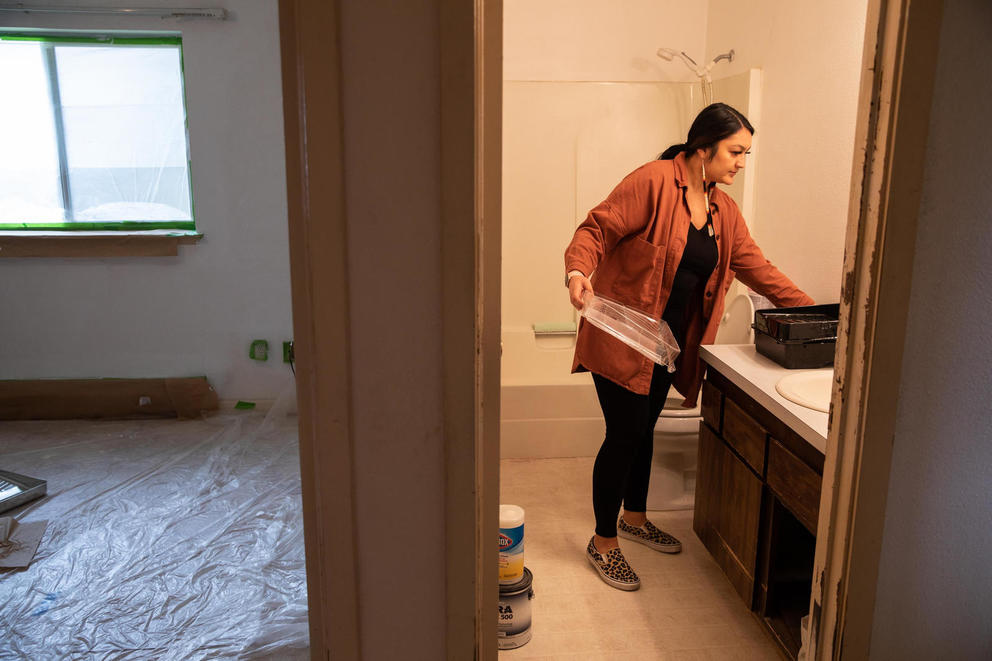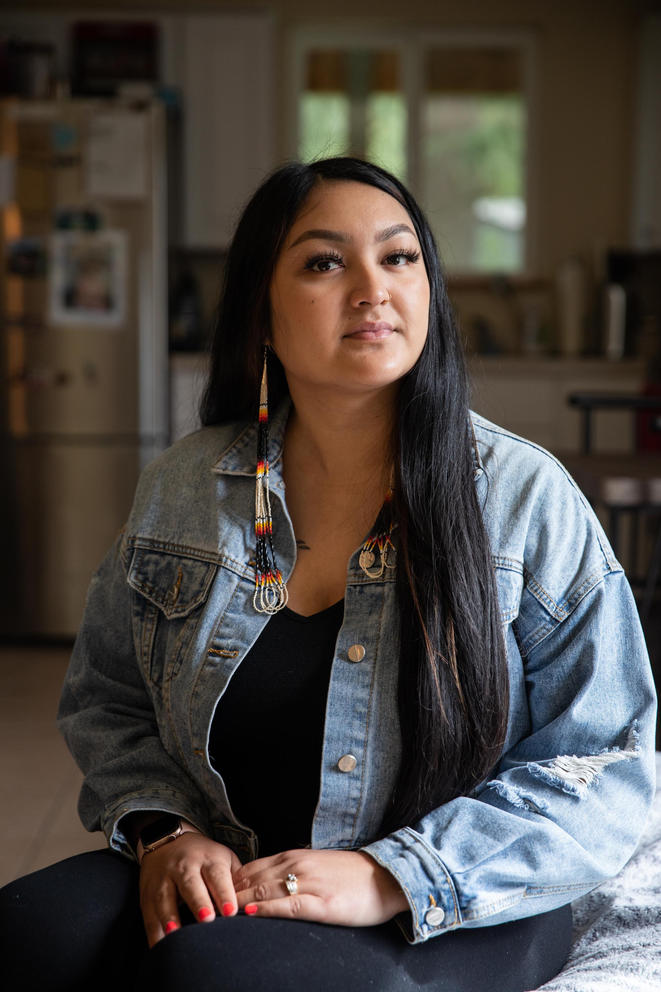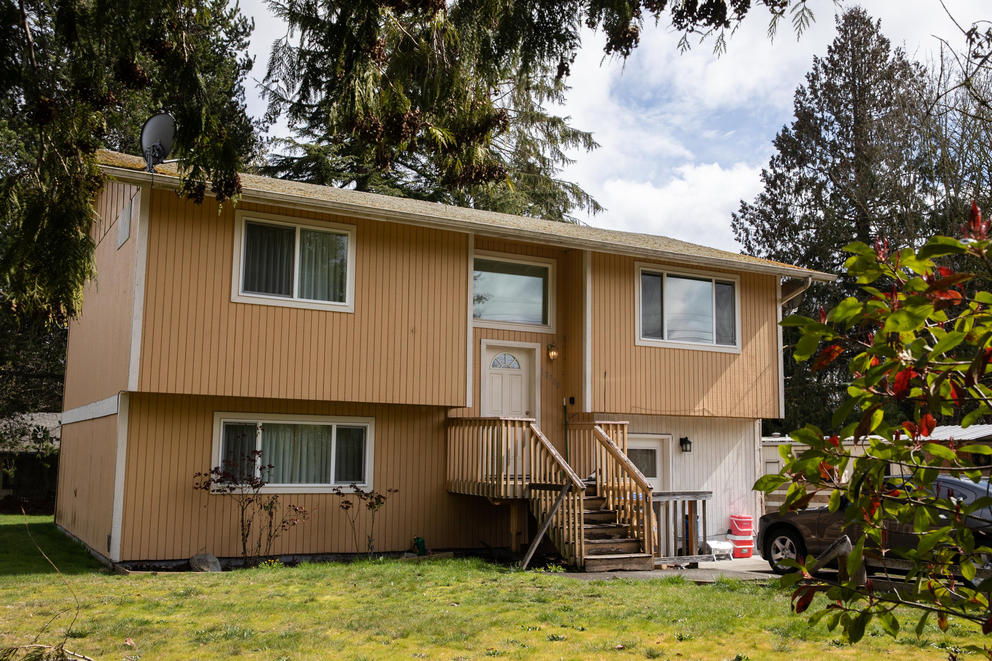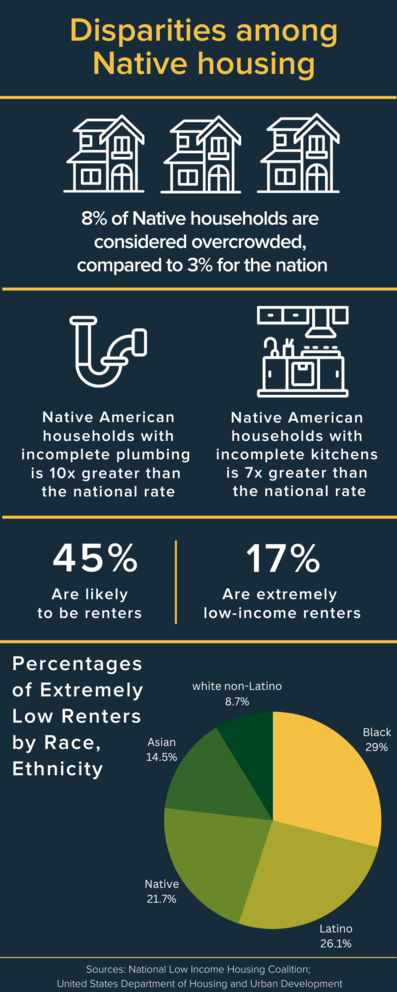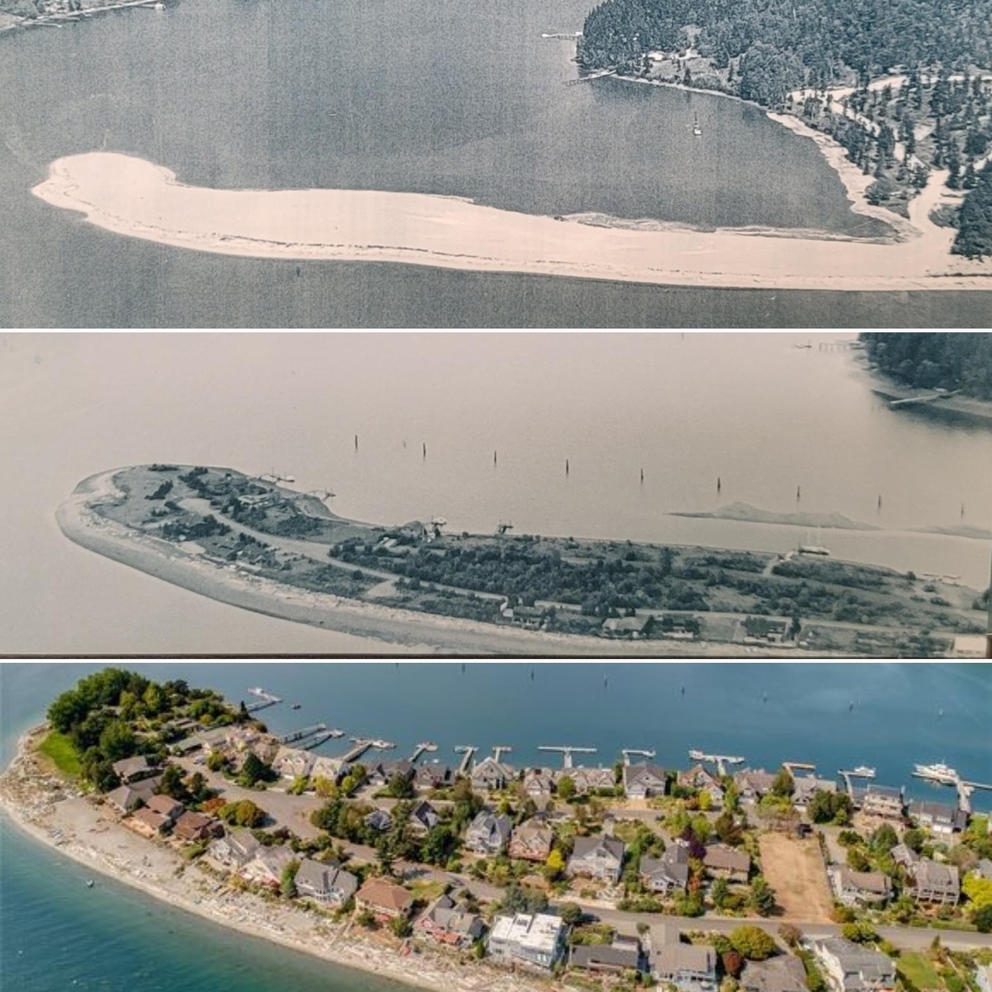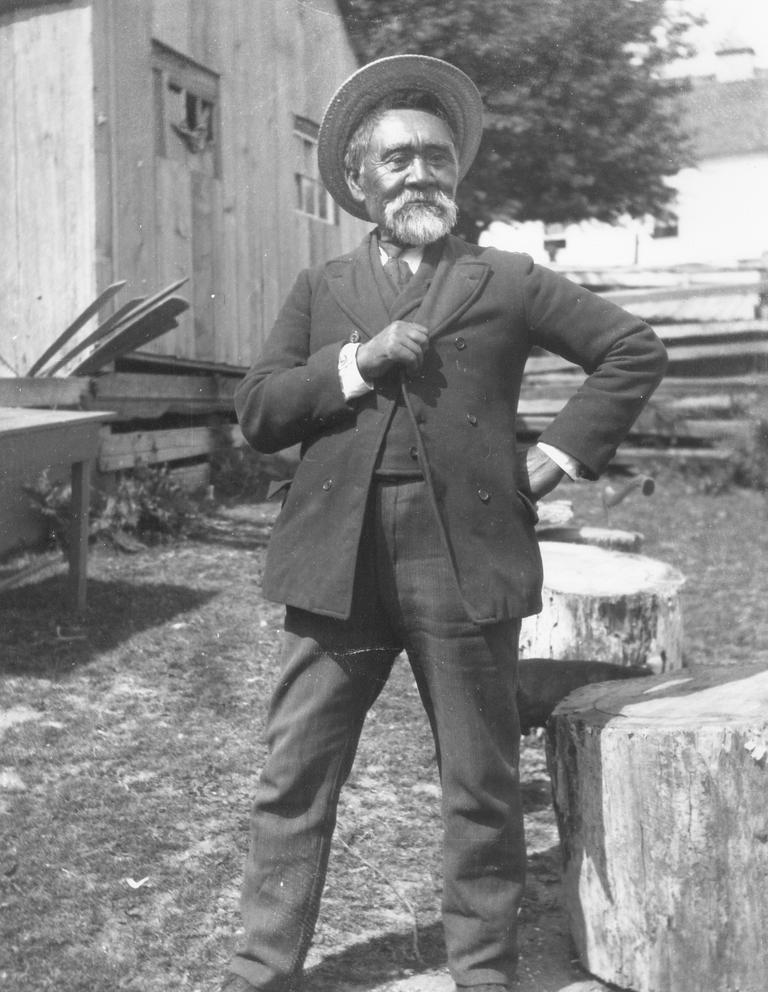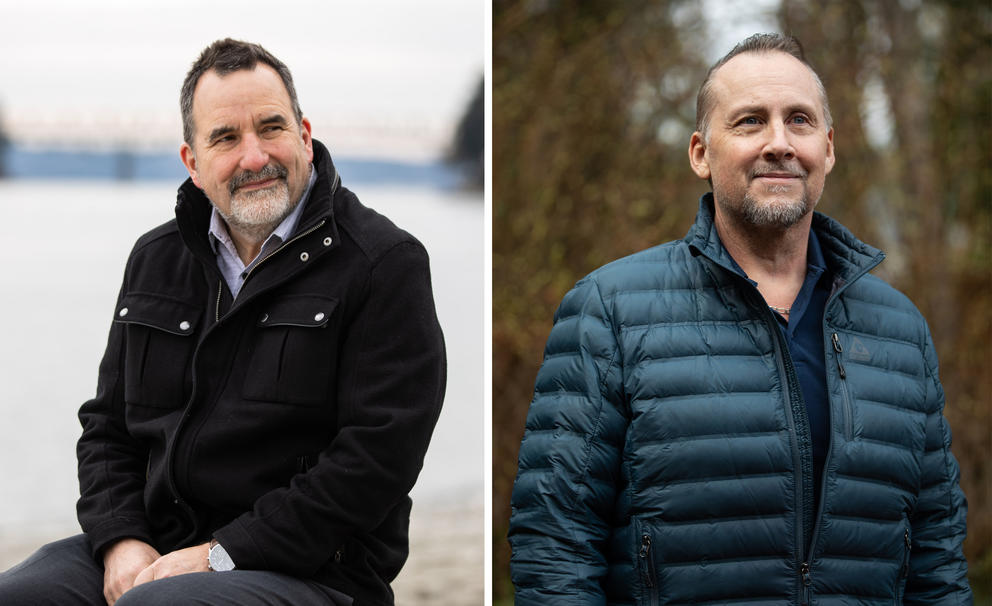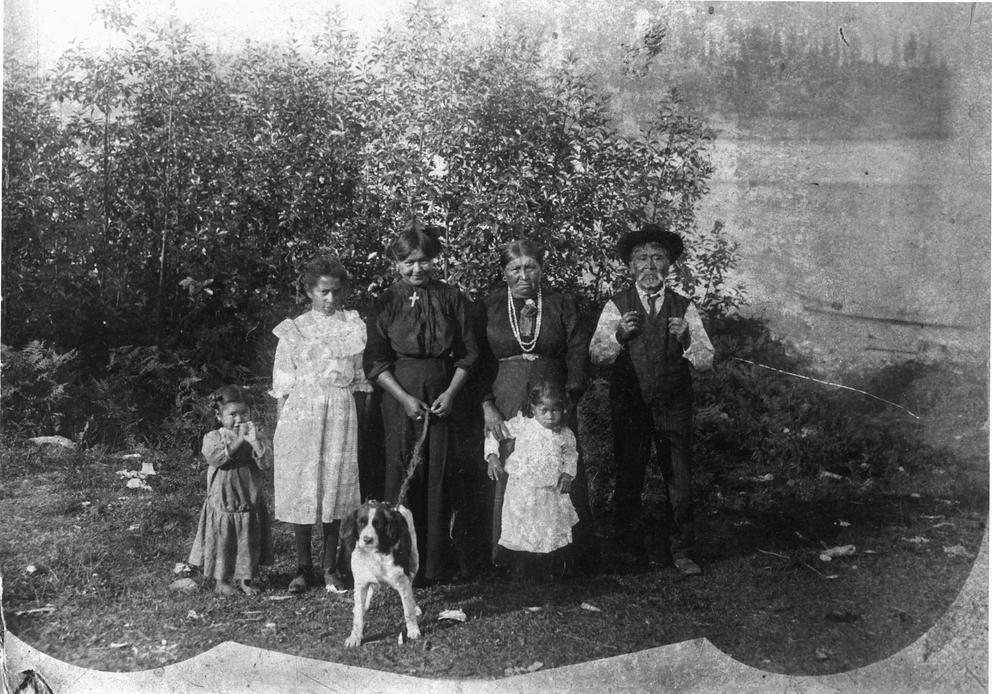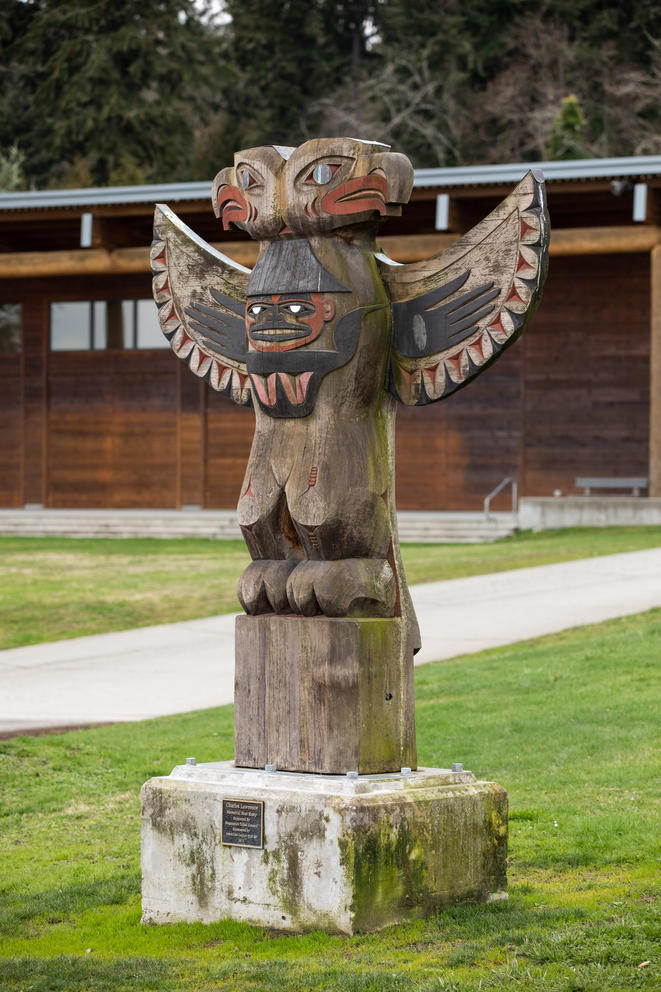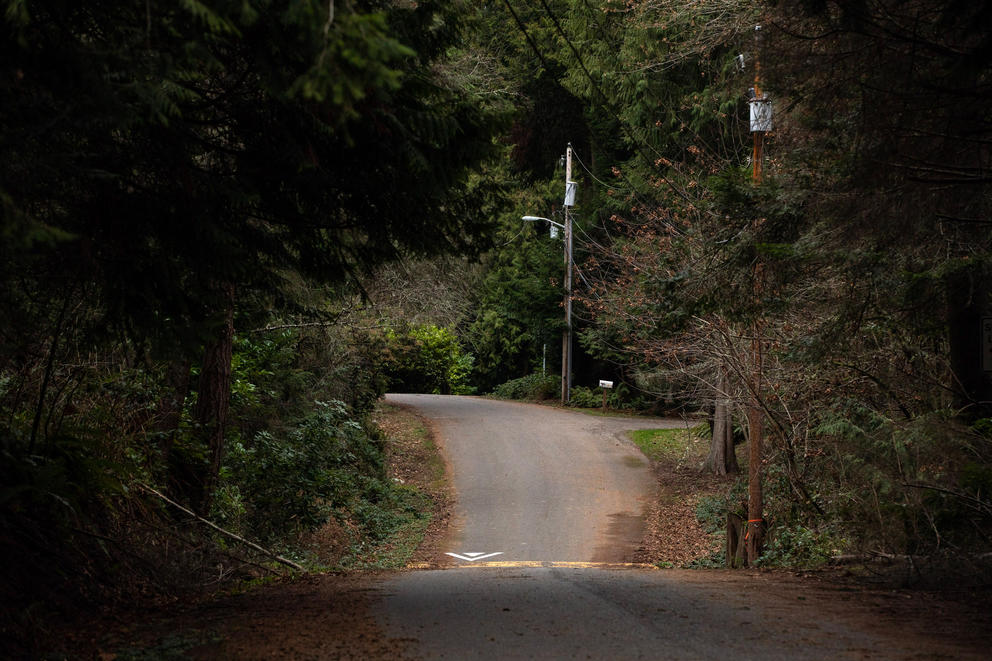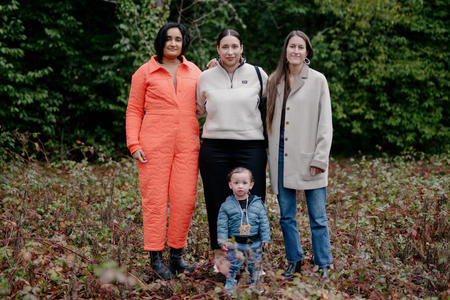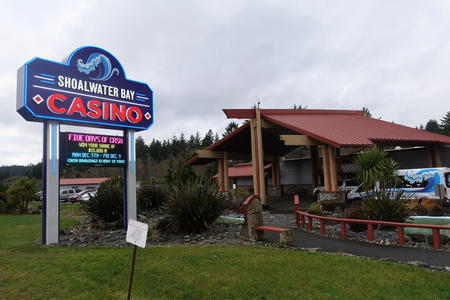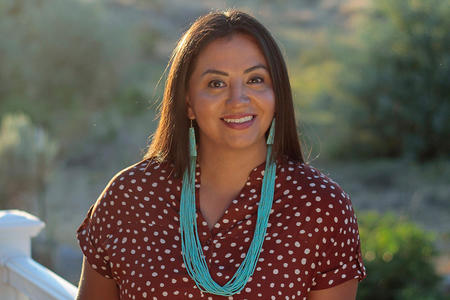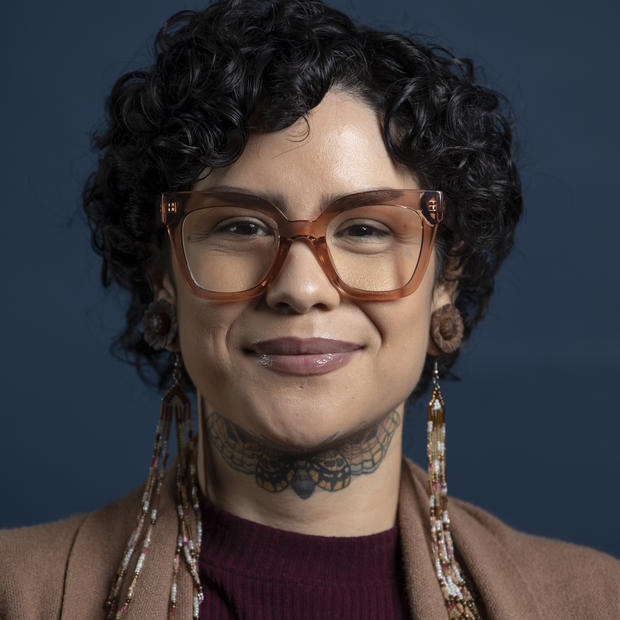Recent federal funding is changing this for some Suquamish citizens and allowing them to come home. The Suquamish Tribe has allocated $15 million from the Biden Administration’s 2021 American Rescue Plan for housing projects they hope will bring their citizens home. The money is being used to build affordable housing and also provide financial assistance. It is working to meet each citizen where they are by providing a range of services like mortgage subsidies, subsidized rental houses, rent-to-own homes, repair and maintenance programs, and building small studio homes and tiny homes for their citizens.They even provide financial counseling classes to help citizens get to a place where they can qualify for a home loan.
One result of this investment has been Chargualaf’s return to her community on the reservation. In February she purchased a house with down-payment support from her nation.
She says she wants her children to be able to experience the community she had as a child. “It started off as a dream,” she said. “I didn't think I would ever be able to buy a home, but I knew when I decided that I wanted to start having kids, [that] I wanted to be able to provide secure housing in a community that they would feel safe in and to be able to be a part of our culture and the tribe that has helped us all throughout our lives.”
Before the move, Chargualaf had been commuting up to 25 minutes to her work as the higher education manager for the Suquamish Tribe. She had applied for tribal housing, but married couples with kids are prioritized, and housing would fill up before her name came to the top of the list. When she learned about the down-payment assistance program, she jumped at the opportunity. Now she lives just five minutes away from her childhood home where her mom and siblings still live. She is able to get to work and also participate in community events without having to worry about travel time.
The challenges that confronted Chargualaf – and continue to afflict those with even greater separation from their peoples’ home lands – have historical roots. Housing on reservations has been a problem since the federal government forced Native people off their lands over 150 years ago.
Now, as nations like the Suquamish start to bring their people home by reacquiring land and building more affordable housing, citizens who never had the opportunity to live on the reservation are connecting with family, community, culture, language, spirituality and their ancestral land for the very first time.
Theft of lands
The Suquamish name comes from the traditional Lushootseed phrase for “people of the clear salt water.” Before white colonists arrived in what they would later call Washington, the Suquamish lived in villages along the shores of Puget Sound, where longhouses occupied by extended families faced the water. They are traditionally fishermen, canoe builders and basket weavers. Their villages stretched from Port Ludlow south to Vashon Island, where for thousands of years they traded and intermarried with the Pacific Northwest’s other Native nations. When settlers arrived they brought measles, smallpox and other diseases, and, as happened throughout the nation at the time, many lives and lands were soon lost.
In 1855 the Suquamish Tribe signed the Treaty of Point Elliott, establishing the Port Madison Reservation on land that included one of the nation’s primary winter villages, Old Man House – once home to Chief Seattle and Chief Kitsap. When negotiating the treaty, the Suquamish were forced to give up much of their land encompassing most of what is now Kitsap County. In exchange, Gov. Isaac I. Stevens promised to give them houses so that they could cultivate the soil.
Nearly all Native people across Indian country suffered a similar fate in the decades that followed, though many remained in small areas of the reservations, where they continued to live communally with one another as they had for thousands of years.
That ended with the U.S. government’s passage of the General Allotment Act of 1887, also known as the Dawes Act, which split entire reservations up into portions of land for individual Native families. These families were expected to move to their allotted land on the reservation and farm. As communal people for thousands of years who don’t see land or other people as things to be conquered, and who knew just how abundant their lands were without farming them the way their oppressors preferred, allotment didn’t work as the government had hoped.
People often refused to move to their allotments. Under pressure from angry settlers, the federal government seized what they called “surplus lands” if Native people weren’t using them as the government saw fit; or they were seized by federal “Indian agents,” white civilians authorized and appointed by the U.S. president to act as ambassadors to Native nations.
Indian agents could claim Native families were “incompetent” for reasons such as being unable to speak, read or write in English. If a Native family was found “incompetent,” the Indian agents could seize and auction off their allotted land. Native land could also be taken out of trust if the landowner was deemed incompetent, which would make it taxable — so many people lost their land in tax foreclosure auctions. Leonard Forsman, Chairman of the Suquamish Tribe, says documents detailing this history are now part of the Suquamish records.
Kali Chargualaf and her partner were able to move back to the Port Madison Reservation and buy a home there after receiving down-payment assistance from the Suquamish Tribe through the American Rescue Plan funding. Chargualaf works as the higher-education manager for the Suquamish Tribe. (Amanda Snyder/Crosscut)
Much of this resulted in the Port Madison Reservation becoming a “checkerboard” reservation, with some land owned by the nation and some by non-Natives. This made building sustainable housing increasingly difficult.
During this period, many Suquamish refused to move and remained at the winter village until 1904, when the U.S. military claimed the land to build a fort there. The military took much of the reservation’s waterfront land, including the location of Old Man House.
But instead of building the fort, the land was sold to developers who divided it into lots for waterfront homes for non-Natives. Once the land was out of Suquamish ownership, county covenants required that landowners only sell to white people.
Similar development was happening on the other side of Miller Bay in Indianola, where Chief William Rogers had moved in 1902. A chief of both the Duwamish and later the Suquamish, Rogers had moved to a land allotment on the Port Madison Reservation after Duwamish longhouses in what is now known as Renton, where he lived, were burned repeatedly by settlers. In1910, that allotment land was taken by an Indian agent, who claimed Rogers was “somewhat addicted to alcohol,” according to documents from the time. Rogers led the Suquamish Tribe in 1911 and lived and raised his family on the Port Madison Reservation with his wife Annie until he died in 1925.
“That was a place to duck-hunt, to dig clams,” says Rogers’ great-great-great-granddaughter Angee Harrington, the collections management specialist at the Suquamish Museum who provided Crosscut with the documents from the Indian agent. Harrington’s ancestral name is Wahalcut, given to her in a ceremony for carrying on cultural work.
“It's a real sore spot every time I see those multimillion-dollar houses out there on the spit.”
The houses Harrington refers to sit on what is now Northeast William Rogers Road, named after her ancestor, Suquamish Tribal Chairman Lawrence Webster, Harrington’s great-grandfather, who in 1979 attempted to file a claim for violation of property interests concerning Chief Rogers’ land, but missed a deadline for consideration by two months.
The sand spit that the multimillion-dollar homes now sit on was once “clam heaven,” according to Forsman. He remembers riding his bike past the waterfront homes as a kid. “It's traumatic,” he said.
An affordable-housing crisis
The promise of housing Gov. Stevens made to the Suquamish was not unique. When the U.S. government displaced Native peoples from their homelands, their people and their culture, housing programs were an agreed-upon treaty obligation. Yet those treaty obligations remain unfulfilled for the Suquamish and many sovereign Native nations all across Indian country.
The need for housing programs remains. The U.S. Department of Housing and Urban Development released a report in 2017 showing that at least 68,000 housing units are needed across Indian Country. “The cost to develop 68,000 units could be $20 billion [per year] on average development costs alone, so giving tribes less than a billion a year certainly is not making any progress towards this larger need in our tribal communities across the country,” said Tony Walters, executive director of the National American Indian Housing Council.
The housing that is available is disproportionately substandard. The U.S. Department of Housing and Urban Development determined in 2010 that approximately 543,000 Native American households experience “severe housing needs,” defined as “living in conditions that are overcrowded, substandard, or cost-burdensome.” Eight percent of Native households are considered overcrowded, compared to 3 percent for the nation as a whole. HUD research also revealed that the number of Native households with incomplete plumbing facilities is 10 times greater than the national average, and the number with incomplete kitchen facilities is seven times greater. By 2013, the National American Indian Housing Council estimated that 70 percent of the homes in Indian Country were “in need of upgrades and repairs, many of them extensive.”
In addition, almost 40 percent of all Native households in Washington are overcrowded or cost-burdened, meaning they pay more than 30 percent of their income for housing, according to a 2022 Washington Department of Commerce report. This cost burden results in higher rates of homelessness. Native people make up about 3 percent of Washington's population, but represent 11 percent of the state's population experiencing homelessness and over 18 percent of the unsheltered homeless, according to 2020 Point-in-Time counts.
The need has become more urgent as the Native population continues to grow. And according to the Broken Promises report, the Native population is growing at twice the rate of the national average.
In 2018 the United States Commission on Civil Rights released Broken Promises: Continuing Federal Funding Shortfall for Native Americans (an update to the 2003 report A Quiet Crisis: Federal Funding and Unmet Needs in Indian Country), revealing the “failure of the federal government adequately to address the wellbeing of Native Americans over the last two centuries.”
The report focused in part on the Native American Housing Assistance and Self-Determination Act of 1996, which, in an effort to simplify the tribal housing development process, eliminated several separate housing-assistance programs that had served Native Americans and replaced them all with the Indian Housing Block Grant.
The Block Grant has contributed to 38,000 affordable-housing units and rehabilitated an additional 770,000 housing units in Indian Country since its inception, according to the Broken Promises report. But the funding has not kept pace with inflation or demand. According to the Broken Promises report, these funds have barely covered maintaining the current housing and eroding infrastructure.
Indigenous nations across the country in the late 1990s got $600 million to carry out their housing programs, said Walters. “If you factor in inflation since the late 1990s, it would be well over $1.1 billion today, so tribes are actually operating with less money today than they were in the late ’90s to carry out housing programs. Certainly not enough to meet the need, to meet the demand, to meet just inflation costs and cost of development.”
The Broken Promises report revealed that the federal government’s ongoing failure to increase funding for the Block Grant program under NAHASDA has steadily eroded the number of new affordable-housing units developed in Indian Country each year.
“The United States expects all nations to live up to their treaty obligations and it should live up to its own,” the Broken Promises report reads.
HUD acknowledged to Crosscut that even with the increased funding through the CARES act and the ARPA, funding still falls short of addressing all the housing needs in Indian Country.
For remote rural nations, there is the added cost barrier of creating the necessary infrastructure, like plumbing and electricity. Hiring contractors to build infrastructure can also be difficult for nations in rural or hard-to-access Olympic Peninsula areas because of their remote locations and a lack of available workforce housing, according to the Washington Department of Commerce report. This was only exacerbated by the COVID-19 pandemic, which delayed or canceled many projects all across the country due to supply chain issues.
Cultural conflicts and comrades
According to Forsman, returning reservation lands back to their original stewards is critical to reversing the housing crisis for Native nations.
As Chairman of the Suquamish tribe, Forsman has made every effort to reacquire land on the Port Madison reservation that had been lost or stolen. At a low point, the nation and its citizens owned only about 30 percent of their own reservation. Now the Suquamish Tribe and its citizens own about 60 percent of the Port Madison Indian Reservation.
“We've been actively reacquiring land primarily for housing and some cultural recreational purposes,” Forsman said.
As awareness and relationships between the Suquamish nation and local government develop, so too have opportunities for working together to return land to the nation. Kitsap County Commissioner Robert Gelder is working with the Suquamish to transfer certain county-owned parcels of land and public-right-of-way land within reservation boundaries back to their original stewards. The largest property would be the Indianola preserve waterfront, which the county has conservation easements over. There are also a few other smaller park properties within Suquamish itself.
“Whatever small part that I can play in my role, or the county can play, is to continue to shift that patchwork to one that is fully under tribal control,” Gelder said. “My objective, really, is this transfer of ownership.”
According to Gelder, another non-Native Port Madison resident, who has asked to remain anonymous, has offered to deed her land to the Suquamish tribe when she passes.
“Some people have donated [their land], some people have come to us before they sell [their land] on the market, so that's been a growing movement that we hope will continue,” Forsman said.
Forsman calls commissioner Gelder one of the Suquamish’s supporters. Gelder has started an online community outreach forum, Port Madison Dialogues, to build relationships and increase awareness about the history, culture and current issues facing the Suquamish Tribe to foster a greater level of community understanding and support.
This new outlook and respect for tribal sovereignty by some non-Native residents is a breath of fresh air for the Suquamish Tribe. In the mid-1980s, the nation attempted to re-establish ownership and title to the tidelands in front of Angeline Avenue, but were met with outrage. In 2001, when the Suquamish Tribe was building a low-income housing development near their casino, the protests began again.
Sarah Van Gelder had just bought a modest house along Angeline Avenue. “My neighbors knocked on the door to say, ‘We have to stop this housing project because we don't want those people in our neighborhood,” Van Gelder said.
She went to a community meeting about the housing project, where she listened to an hour and a half of people talking about why they didn't want “those kinds of people in our neighborhood.”
“I finally stood up and said, ‘Of course they have the right to build housing on their own reservation. We should be as welcoming as they were when settlers first came to this region,” Van Gelder recalled. She left early because she felt isolated and a bit scared. Elder Ted George, who had been listening to the whole meeting, followed her out and thanked her for speaking.
A few weeks later, Chief Seattle’s grave was desecrated. In response, Van Gelder, George and a large group of Native and non-Native people came together to form Suquamish Olalla Neighbors. They worked to reinforce and support tribal sovereignty each time it was challenged by the Port Madison Property Owners Association, which was run by affluent neighbors along Agate Passage where the waterfront Angeline Avenue homes are located.
The property-owners’ association even filed a lawsuit challenging not only the reservation boundaries of the Port Madison reservation, but the legitimacy of the Suquamish Tribe as a whole.
Van Gelder now works as the communications manager for the Suquamish Tribe.
“The residents were saying that we have to comply with county zoning, and we said, ‘Well, no, we establish our own zoning based on our needs, just like you do,’” Forsman said. “This is our land and our people. We’ve been here forever so we’re going to decide how dense this housing is going to be because we don't have many places we can build. You've already built up most of the land here. So we’re going to do what we have to do.”
In 2003, the Suquamish Tribe requested from the Washington State Parks and Recreation Commission the return of the one-acre park where Old Man House once stood. Many non-Native Suquamish area residents opposed the transfer of ownership to the Suquamish Tribe for fear of losing access to the park, which sits near waterfront homes. The Suquamish agreed to keep the park public, and the portion of the land that was in essence stolen in 1904 by the federal war department was transferred back to the Suquamish in 2004.
“I think [the hostility] is still present on some levels, but for the most part, people are supportive,” Forsman said.
Housing projects
The growing presence and awareness of the Suquamish people has positively impacted the acceptance and support of Suquamish development among the non-Natives who live on the Port Madison Reservation, according to Forsman. In 2018, 36 acres of waterfront land was returned to Suquamish control after a 50-year lease had been fulfilled. Now the nation is utilizing this land for housing and community building.
Twenty two- to four-bedroom townhomes are being built through a combination of American Rescue Plan funding, HUD Community Development Block Grant money and over 50 percent tribal funding for the $9.5 million dollar project. The Enetai Townhomes will include some common areas, including picnic tables and benches for community gatherings.
Having tribal housing near the Suquamish waterfront again is a great homecoming, according to Scott Crowell, a Suquamish citizen and the community development director.
“So much of the waterfront areas that we have on the reservation were lost or taken away, and there aren't very many places for people to go and enjoy the water,” Crowell said.
The proximity of the townhomes to a number of community resources, including the Suquamish Museum and the House of Awakened Culture – a Suquamish longhouse and community center, a ceremonial area, a new park, an elder center, a medical clinic and an open waterfront for Suquamish citizens to enjoy – has made this even more monumental, according to Crowell. The communal growth is a part of reclaiming the land in community with other Suquamish citizens that hasn’t been possible until now.
It was important to Crowell that the housing was part of a much larger planning structure for a culturally significant area, not just the houses.
“You go past the Veterans Memorial, you’re at the museum; you cross the street, you’re at the medical clinic; you walk back down to your house and do the circle here and now you’re at the elder center,” Crowell said.
Less than two miles away is another major project, the Snooker neighborhood development, which is financed in part through over $2 million in American Rescue Plan funds. The Suquamish Tribe bought a dozen lots, about a quarter-acre each, off of Totten Road and are putting in the infrastructure, including roads, water, power, sewer, stormwater and broadband connectivity for Suquamish citizens to build their own single-family homes on.
“It allows [Suquamish citizens] to get into a much better home than they would have been able to get into if they had to go buy the land and the water and the power and the sewer,” Crowell said. “It allows them to afford much more house for a lot less money.”
These houses are meant to stay in each person’s family for their lifetimes and be something they can pass on to their children. They will never be able to sell it because the underlying land is trust land, owned by the tribal government.
“For a lot of people, that’s fine,” Crowell said. “They’re not looking at their home as an investment to cash it out in 10 years and upgrade to a bigger home. It’s generally not done that way around here. Most of our citizens, they never really leave. Our society tends to stay.”
The relief funding sped up their ability to implement big plans like the Snooker neighborhood. At least 80 households are still waitlisted for housing with the tribal housing authority.
The Suquamish have seen greater economic prosperity since 1995 when the nation opened their casino, which has afforded them greater opportunities to buy land and build more housing. Several other tribes, including the Samish in northwestern Washington, are making progress toward housing their own citizens.
Many nations understand that bringing citizens back to their ancestral homelands to be in community requires access to housing. The Samish Indian Nation is building its first housing project, called Xwch’ángteng (whuh-CH-ang-tun), which translates to “a place of coming home” or “place of being brought home,” in what is now known as Anacortes.
A long way to go
When asked if the agency thought the federal government had adequately fulfilled their treaty obligations and where they see room for improvement, Josh Barnett, director at the Office of Public Affairs for the Bureau of Indian Affairs, redirected and said the responsibility for upholding treaty obligations falls on the entire U.S. government.
“Indian Affairs will continue to work in partnership with Tribes and other federal agencies to ensure that every Native individual and family can have a safe, secure, and sanitary place they can call home,” Barnett continued in an email.
“I don't think anyone can say yes to that,” National American Indian Housing Council executive director Tony Walters said in response to the same inquiry about upholding treaty obligations.
Walters says he believes that at some point there needs to be a reckoning and the federal government needs to honor the treaties, which is why groups like NAIHC keep the pressure on and advocate for the reauthorization of NAHASDA to create greater accountability in keeping the trust responsibilities. But, he says, there is still a long way to go.
“The federal government needs to step up and start investing in housing solutions at the scale that's needed,” said Sarah Saadian, senior vice president of public policy and field organizing at the National Low Income Housing Coalition.
Saadian believes that acquiring accurate data for each individual Native nation is imperative to hold the federal government accountable. There isn’t much data on the most remote and impoverished nations across Indian country, she says.
“Some of the partners that we've worked with have proposed a tribal census where the federal government would provide resources to tribes to do their own data collection so we could better understand those needs,” Saadian said.
The Broken Promises report also called for more accurate data, including “an annual report from appropriate federal agencies on unmet essential utility and core infrastructure needs, and the reach of funds appropriated to meet them,” and a study to determine the cost of meeting the essential infrastructure needs in Indian Country so that Indigenous people are given the same opportunities as non-Native communities.
Walters says he believes efforts to help people understand that Native people are still here, and to understand the conditions of nation-to-nation relationships, are also imperative to progress at any level.
Harrington asks that non-Natives be mindful of the land they live on and decide to purchase. “It's turned into this deep-rooted anger,” Harrington said. “I just hope that people are mindful of where they are purchasing their land and what that means, and to look into the history of it.”
Listen to reporter Luna Reyna discuss this story on the Crosscut Reports podcast:
Get the best stories of the week
This weekly newsletter dives deeper into one story and how it was reported, along with curating the best stories of the week.

